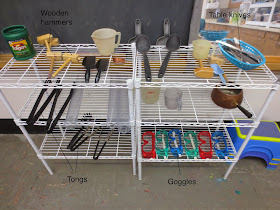
That is unusual because I usually change the apparatus weekly. Sometimes I will leave an apparatus up for two weeks, but then something would be added the second week to change the configuration. Instead of changing the apparatus these past three weeks, I changed what was in the table and the accompanying provisions.
The first week was snow with scoops, containers and people for a Snow Park. The second week was snow with paint and paint brushes for Painting Snow. This past week, objects frozen in ice were added to the table. In addition, wooden hammers, tongs, goggles and table knives were available on the shelves next to the table for the children to use.
One can make an interesting comparison between the different operations fostered by the different provisions on the same apparatus. With just the snow, there was a lot of transporting of the snow with scoops and containers from one table to the other actually using the apparatus. With the paint, the children did much less transporting and much more mixing of the snow and paint. The wooden tray was used a lot, but the inclines were used as a painting surface. With the ice, the apparatus seemed to take on even less significance. What came to the fore were the physical operations to free objects from the ice. Maybe the sheer physicality of the invitation trumps all other operations.
Watch as this child tries to free the dinosaur from a piece of ice. Notice how much zest he puts into his swings with the hammer.
There must be a feeling of satisfaction to be able to break pieces of ice off a larger piece with force. That is true for both boys and girls. Maybe the guy in me appreciates an outlet for some constructive brute force.
I have done this activity every year for 20 years. You can read some earlier posts here, here and here. I remember as a child growing up in Minnesota finding things frozen in ice. My friends and I would take to smashing the ice with sticks and rocks to free the objects. In a way, I am trying to recreate that same experience for the children in the classroom. With little or no direction, the children understand the invitation.
A mother reported this year that her child asked to make "ice toys" at home. He told her they needed goggles, knives, hammers and toys to freeze in ice. The mom asked how do we do that. The boy told her to just look at teacher Tom's blog to find the instructions. When there is transfer like this to home, I know the venture is worthwhile. So go ahead, make some "ice toys" and let the children pound and chop away.


















